Oops

I imagine the 4 men looking in the pit are saying "Well...E36 M3."



Today, in 1832, Strasburg Railroad was chartered by the Commonwealth of Pennsylvania. It has operated continuously since then, under the same charter and the same name, making it 188 years old today, and thus the oldest continuously operating railroad in North America.

PRR A5s 0-4-0 #713 backing along the streets of Atlantic City in 1954. The PRR's A5s were the largest 0-4-0s built in the US. PRR was also one of the only Class 1s to roster an 0-4-0

Finally, some good news on the C&O #1309 restoration that Western Maryland Scenic Railroad has been undertaking. They re-wheeled the rear engine on the big 2-6-6-2 yesterday
This restoration has been one dumb move after another, so it's good to see some forward progress.
So, what is the deal with WMSR/C&O #1309? Well, first, a little dive into WMSR's history is required. The WMSR was opened in 1988, using the old Cumberland-Frostburg branch line that had been operated by the Western Maryland Railway. It's pretty rugged territory, running in a valley with some stiff grades, but very scenic. The operations originally used an ex-Boston & Maine Alco RS3, an ex-Chicago & Northwestern Alco RSD-5 #1689 and some ex-Canadian National/VIA Rail Alco FPA4s (an FA configured for passenger use), one of which was #305. All the locomotives were done up in the classic Western Maryland fireball livery



The tracks had previously been used by a line called the Allegheny Central, which had used a pair of Canadian Pacific G5-class Pacifics, the #1238 and the #1286. After the Allegheny Central folded up and the Western Maryland Scenic opened up, the two CP Pacifics were operated on the WMSR by their owner, Jack Showalter, until the WMSR and Showalter reached an impass on negotiations and Showalter left/was evicted (depends who you listen to) and took his two engines with him.
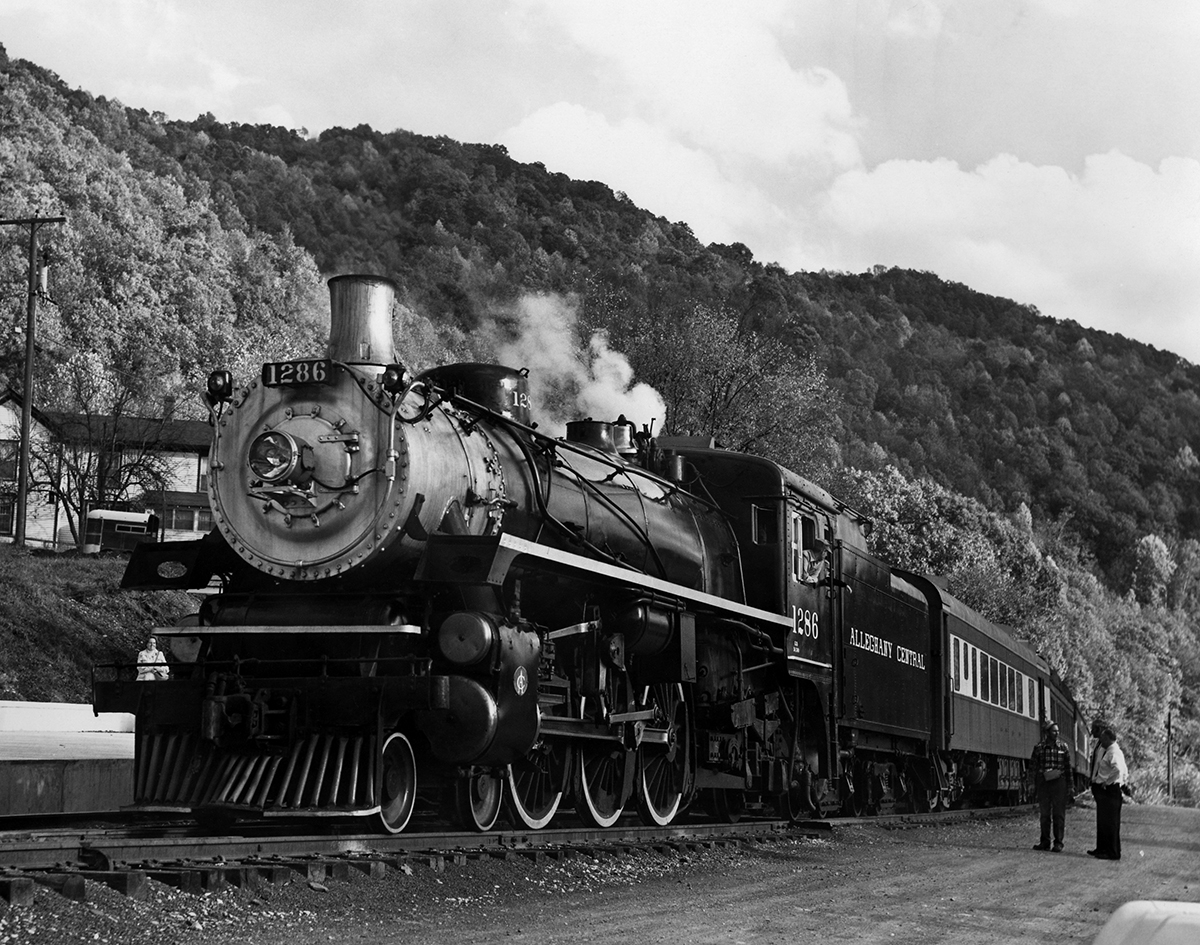

Realizing that steam was a big draw, WMSR wanted to get steam operations going again, and preferably with a Western Maryland engine. Now, the WM had the biggest most powerful 2-8-0s in the US, along with some serious Decapods, massively powerful Challengers and some handsome Northerns. The problem is, the WM didn't save any of that stuff. The only preserved WM engine is #202, a high-drivered Pacific that isn't well-suited to that territory. Enter Lake Superior & Ishpeming #34.

The LS&I also had some beefy Consolidations, second to only Western Maryland. And there are a whole bunch of preserved LS&I Consol's. So, WMSR grabbed the #34 from the Illinois Railroad Museum, where she was languishing, spent a few years restoring it and dolled it up as a Western Maryland 2-8-0, renumbering it to #734.


The pilot is different, and the #734 doesnt have her air pumps under the left running board, plus she's about 10% smaller than a true WM 2-8-0, but it was relatively convincing, compared to, say, "Clinchfield #676" or "Delaware & Hudson #302". The #734 wasn't a fast engine, but it had the power to haul trains up through the Narrows. For 23 years, #734 was the main draw at WMSR. The old Alcos left the property, replaced with ex-Conrail GP30's done in the Western Maryland "circus" livery and fireball livery.
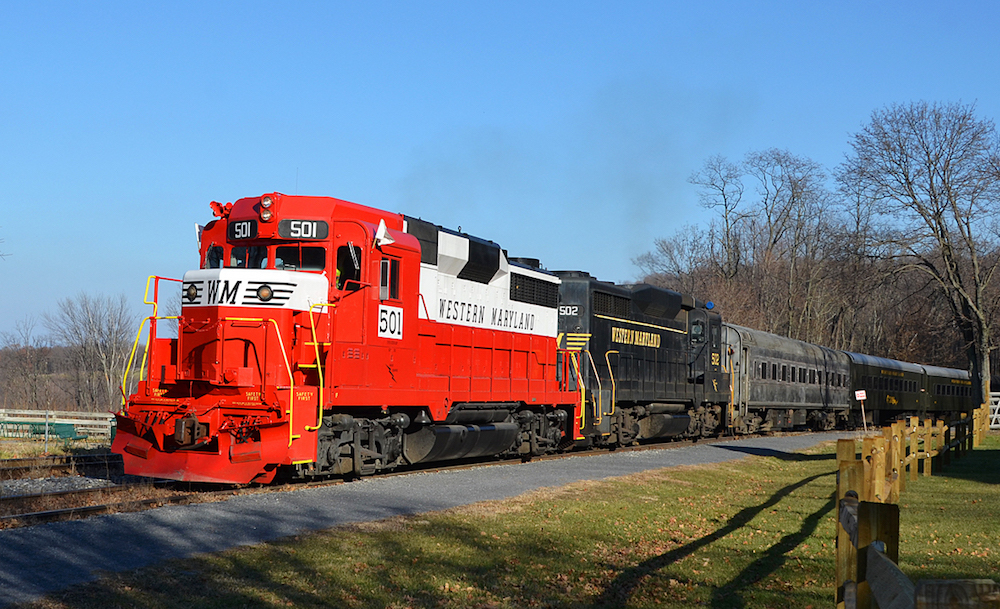
In 2015, the #734 was coming due for another FRA 1472 overhaul. But the WMSR decided not to tear down the #734. They had several reasons: One, they felt like the #734, after 23 years, had lost its novelty to people. Two, the steep grade and heavy trains meant that #734 was flat worn-out and was going to need more than just boiler flues. Three, business had grown and the trains gotten longer and the WMSR was having to assign a diesel as a helper for the trip. This meant they were paying a second crew, and spending money on fuel for both engines, and imparting wear and tear on both engines. So, a decision was made to retire #734 and get a larger engine.

Now Chesapeake & Ohio/Hocking Valley #1309 enters the picture. #1309 is a C&O H-6 class 2-6-6-2 compound articulated, ordered by the C&O in 1949 from Baldwin Locomotive Works. Originally there was supposed to be 25 of them, but coal labor unrest caused C&O to back the order down to just 10 and the #1309 would be the last in the H-6 class, as well as the final steam locomotive produced by Baldwin for the North American market. These engines were interesting in that they were a throwback, basically an updating of earlier C&O 2-6-6-2s dating back to 1911, receiving advancements like roller bearings and overfire jets. Despite their dated origins though, the H-6s were monsters, making 98,700lb-ft of tractive effort at their 56" drivers, while still being relatively compact and flexible.
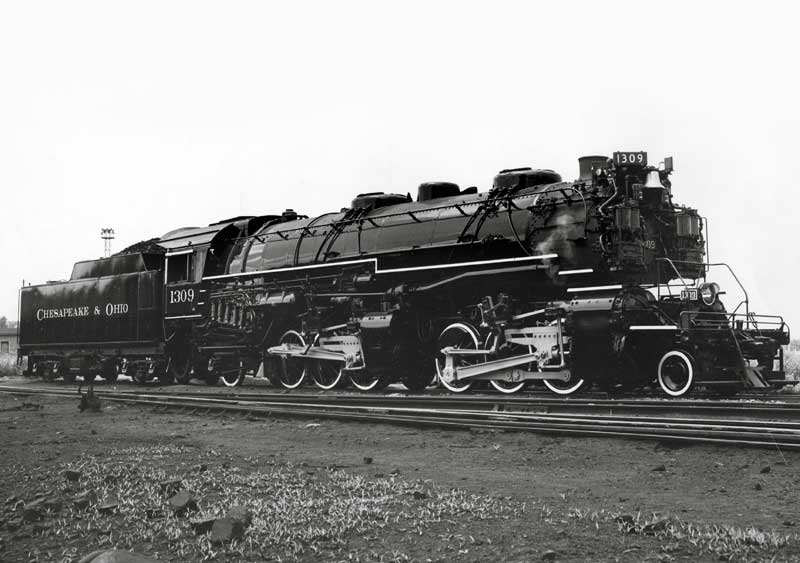

Sadly, being late to the steam party, they had relatively short careers. The C&O retired them in '57, after just 8 years, saving the #1308 and the #1309. The C&O stored #1309 for 20 years at their Peach Creek, VA roundhouse until donating it in '76 to the B&O Railroad Museum. It was moved there and cosmetically restored for display.


In '14, with the plan already made to retire #734, the Western Maryland Scenic cut a deal with the B&O Railroad Museum to purchase #1309, move it to Cumberland, and begin restoring the big Mallet to operating condition. Everyone was pretty excited, as it would give the east coast a new big engine operating. And preliminary checks by the WMSR indicated that all was good, with them saying the boiler was in "like-new condition." The state of Maryland, recognizing the WMSR's tourist draw, decided to chip in a large sum of the cost of restoring the #1309 to operation. The boiler and rear engine were lifted off the lead engine and it was shipped to Cumberland to begin overhaul

Then the bad news set in. First, the locomotive was found to need much more work than originally thought and the price of the restoration spiked to $2 million. (I don't think there has ever been a steam locomotive restoration to be done earlier than expected or cost less money.) Then there was a shakeup in the shop crew, with many experience members leaving disgruntled and the railroad hiring newcomers as consultants. Then new, precision-machined parts were stored outdoors in the weather and rusted up, causing the WMSR to have to order new ones. One of the new shop employees had a rather long list of criminal offenses, but was apparently left to his own devices for days, in which he pressed the brand new brass journals out of the tender trucks and took them to a scrapyard (This is not a simple or quick process, so he was taking apart newly installed components for a while and no one saw or questioned). They were damaged in the removal process and now require another set of new ones to be made. All along, the railroad repeatedly would put on sale tickets for "#1309's first train" and generate a bunch of hype, with the deadline only a month or two away and the engine still in pieces and not even remotely done. Then it would get close and they would cancel and refund the tickets and piss people off, only to try it a month or two later.
The state began getting wary that their money was being poorly spent and distancing themselves from the project. Work has started and stopped several times due to lack of funds. The railroad discovered that, suprise surprise, their infrastructure isn't up to spec to support the much larger engine. They need to install more ties per foot of track to manage the extra weight. And they aren't sure if they can physically get the engine on the turntable. #1309 is 99.7ft long and they have a 100ft deck, so its going to require perfect positioning to make it fit. Also, the track leading into the turntable has a 22.5 degree turn and the #1309 is only rated for a 22 degree turn. Plus there is a small vertical climb onto the deck that they think might give the lead engine fits trying to climb.
The problem is, they are now fully committed to the #1309. They have so much money sunk into it, they just can't cancel the restoration. And even if they did, they now don't have the money to give #734 the overhaul she deserves. Also hurting their case is that they were originally saying that when restored, #1309 would be the biggest engine in the US operating. And then UP went and blew that out of the water by overhauling #4014.
But it seems that maybe, with the WMSR finally learning to stop making false promises, and the recent progress in rewheeling the engine, plus Trains magazine pledging funds for the restoration, there is hope for #1309 yet.
They did make a video of them blowing her new whistle, off a Western Maryland 4-8-4 Potomac. Although I would have tried to have gotten footage where the whistle wasn't squeaking like a teenager's voice.
The sheer amount of surviving Lake Superior & Ishpeming 2-8-0s is honestly a little insane. The LS&I owned 12 Consols, some of them inherited from predecessor road Marquette & Southeastern and others built for the LS&I. The ones built for LS&I, were some of the strongest Consolidations around, with some of them making over 73,000lbs of tractive effort. They weren't fast, but the LS&I hauled almost entirely iron ore, with little passenger service to speak of, so that wasn't necessary. The LS&I dieselized very late, in 1962, and all 12 of the Consols were sold to Marquette & Huron Mountain, an excursion railroad that was running on LS&I tracks. The M&HM used primarily #19, #22, #23 and #24. By 1969, most of the steam engines were out of service, and by '74 the place had essentially ceased operation and looked like a scrapyard, with dead steam locomotives and out-of-service passenger cars littering a yard


In 1984, the M&HM officially abandoned, and the 9 remaining locomotives (more on what happened to the 10th, 11th and 12th later) reverted back to LS&I ownership. The LS&I had no need for 9 old inoperational steam engines and began to sell them off, scattering them across the country. Here are their fates:
#18: #18 was sold to Ishpeming Steel in '85, then went to the Lake State Steam Association later that year. It then underwent a massive overhaul, as well as a cosmetic facelift that gave it more of a Santa Fe look. It became the first steam locomotive to operate on the Grand Canyon Railway and ran from 1990 to 2007. In 2008 it was sold to Mt Hood Scenic and ran a few excursions before they determined it to be too expensive to operate steam and then sent #18 on its way to Rio Grande Scenic Railroad, but by 2017 the #18 was due for a FRA 1472 and was taken out of service. When Iowa Pacific Holdings, the owner of RGSR, went under this year, the #18 was put up for sale and is currently listed on Ozark Mountain Railcar, if any of you big ballers want to purchase her.

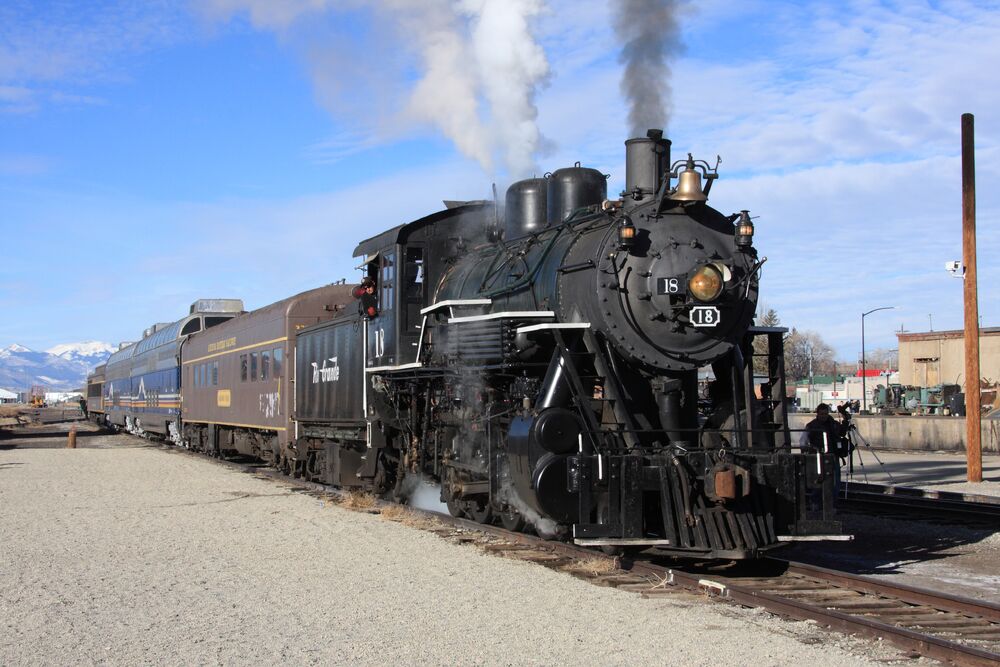
#19: This was also sold to Ishpeming Steel and then purchased by Grand Canyon Railway. They cosmetically restored it but never operated it, instead they put it on display at the MGM Grand in Las Vegas as an advertising tool. Around 2004, the GCR sold it off and it was purchased by the town of Frisco, Texas, who wanted to display a steam engine. Interestingly enough, there are plenty of St. Louis-San Francisco Railroad (aka Frisco) steam engines preserved and some were even up for sale, but Frisco the city didn't care about having an engine of Frisco the railroad heritage. So, #19 is now dolled up as Frisco (the railroad) #19.


#20: Also sold to Ishpeming Steel and then sold to GCR. Similar to #19, it was cosmetically restored and just used on display at their depot. At one point there were plans to restore #20 and #19 to operation but they never panned out. #20 did travel with #18 up to Mt. Hood Scenic but was not operational for the trip and was also displayed there. It followed #18 to RGSR and is currently stored outdoors with no plans to operate

#21: The #21 did not leave LS&I property until 2002, at which point it was moved to Mid-West Locomotive & Machine Works' shop on the old Kettle Moraine Railroad property. It is privately owned and supposedly undergoing restoration but is in poor condition and the restoration has been progressing slowly.
#22: The #22 was last run on the M&HM on Labor Day of 1965. It was purchased by a private owner in 1985, who lent it to Mid-Continent Railroad Museum. During that time, they undertook a restoration to get it operational, but with the restoration nearly complete, the FRA changed their regulations (due to the Gettysburg Railroad boiler failure incident) and the #22 was not stuck in a weird limbo of being freshly restored but not compliant. The mostly-assembled engine would have to be torn down and inspected by FRA inspectors. Instead, the decision was made just to cosmetically display the #22. Note the green boiler jacketing, which is how the LS&I would have had their engines painted.

#23: It was sold before the M&HM's abandonment in 1983 and moved to Kingston, NY, with the plan being to restore it and run it on the Catskill Mountain Railroad. In '01 the restoration started by the CMRR put the restoration on hold for other projects. Then, when they were evicted from the Kingston Yard by CP, they trucked it to Phoenicia, NY and the Empire State Railroad Museum. The engine has been moved inside under a shed since this photo, but is still disassembled and there are no plans at this time to finish it, as the ESRM is a small operation with limited funds and resources.

#24: The #24 was donated to the National Railroad Museum in Green Bay, WI, and was operational on arrival. They used it to pull trains on the property briefly, but retired it fairly shortly. These days it resides there under a large awning on cosmetic display.
#29: #29 also went to Mid-Continent, but then in 1989 was sold to Grand Canyon Railway (yes, GCR owned 4 of the 12 LS&I Consols), who restored it to operation. It ran alongside #18 from 1990-1995, then was overhauled from '95 to '04. It operated from '04 to '08, then was put on display from '08-'16. In '16 it was returned to operation and is still used by GCR but sparingly. GCR has cut down steam operation from regular to once a month during the summer months and there are rumors that once #29 and CB&Q #4960 are due for their next 1472, the GCR will eliminate steam operations entirely.

#32: The one that didn't survive. Or likely didn't. Nobody really knows. #32's fate is a bit of a mystery. The M&HM sold it off in '66 to the US Air Force, who towed it down to Eglin and configured it for remote control(!). It was then used for testing targeting systems for USAF missiles so that they could cripple Vietnamese railroads. No one knows if she was completely destroyed, damaged and then scrapped or is still sitting somewhere in Eglin heavily damaged. The photo is of her being towed by C&NW locomotives away from M&HM property, one of her last sightings.
#33: In 1968, the #33 was purchased by Jerry Ballard to use on the Hocking Valley Scenic. It was overhauled (sadly it's rare tender booster was removed) and put into operation and ran for years but was eventually retired when it needed heavy repairs. In '03, Joe Jerry Jacobson traded the Hocking Valley a diesel for the #33 and restored it to operation. It now has a nice home at Age Of Steam Roundhouse, being lovingly cared for. Note the side rods on the front tender truck in the original photo. It had a steam motor in the tender truck that could be run at low speeds for added power. Very rare.

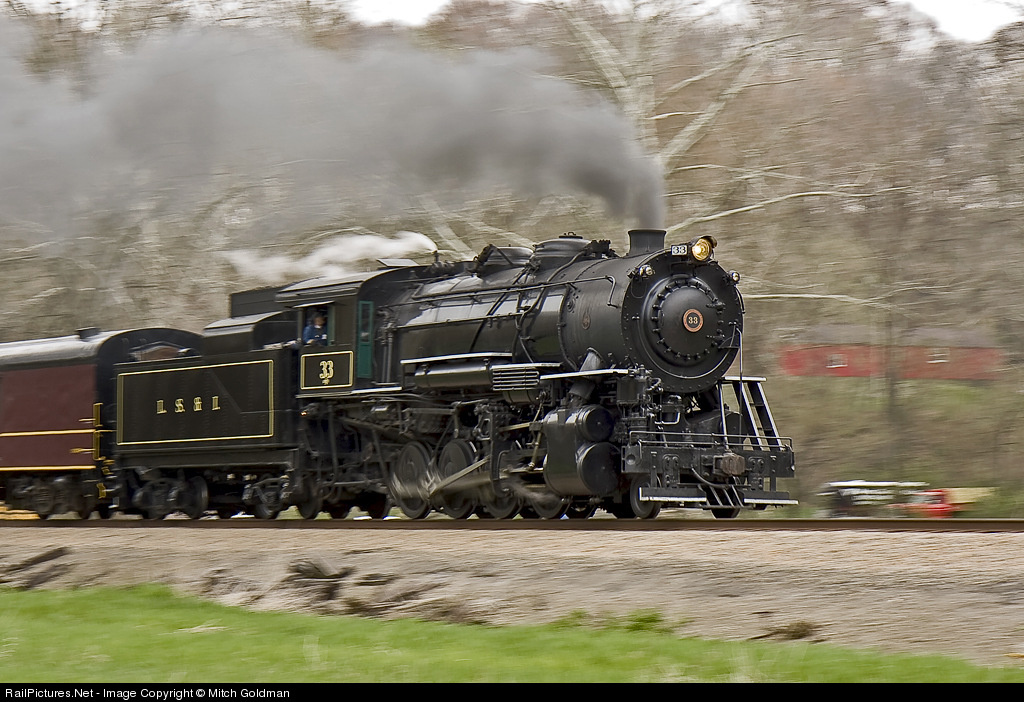
#34: Sold to a gentleman in '71, its tender and cab were badly damaged when vandals lit the coal in the tender of fire. It was subsequently moved to Illinois Railway Museum, with a few delays along the way due to hot journal boxes, where it sat until 1991. At that point, it was sold to Western Maryland Scenic who restored it to operation, dolled it up as a WM Consol and lashed up a NYC Mohawk. It is out of service currently and supposedly heavily worn out, with no plans to be operated.

#35: Sold to a private owner in '85 for the grand sum of $1400.00, the #35 then was sold to Illinois Railroad Museum. Like the #33, the #35 also had a tender truck booster and is still so equipped. This makes #35 one of only two steam locomotives in the US with a tender booster. It is in rough shape cosmetically, but IRM has discussed restoring it to operation over the years. No clue when, or even if, that will ever happen. In the side view, you can see the connecting rods for the tender booster very clearly.
Not a bad survival rate, for a relatively obscure railroad. And other than #21 and #23, they are all in relatively safe, stable homes.
Went down to Little Falls, NY on Saturday to go for a hike with my friend. There's a bridge down there still labeled for New York Central Systems that I hoped to snap a picture of, but the trees obscure it with the leaves on. But on the way back out of town, caught a glimpse of a train parked just outside of Little Falls. And it was painted up for BNSF. I can't recall ever seeing any BNSF units in this area, so I stopped and snapped a picture.
Also, used the big GE as a backdrop for a photo of my car.

In reply to NickD :
Very impressed with the page count of this thread, as well as your dedication as a railroad historian. It is both encouraging to hear of various current restoration efforts on steam locos, and also sad/surprising to know that so many railroads couldn't scrap virtually all of their engines quickly enough.
Appreciate your information on the WMSR. It's been many years since the family and I took their excursion ride, but it was a memorable experience.
In reply to Pete Gossett (Forum Supporter) :
I hate that Ozark Mountain Railcar won't let you look at the prices unless you make an account with them. I'm kind of curious what an operational LS&I Mikado goes for. They also have a Florida East Coast Pacific , a narrow gauge Shay from West Side Lumber and a couple of tiny Porter sugar plantation tank engines. And on the diesel side, they have some old EMD F7s and FP10s, a couple E-units, an ex-NASA Alco S2 and even a Fairbanks-Morse H20-44 (that's a real rare bird)
https://ozarkmountainrailcar.com/railEquipmentGrid.php?category=Locomotives
In reply to NickD :
Thanks, I really didn't need to know that site existed... I gues is better start buying powerball tickets.
1988RedT2 said:In reply to NickD :
It is..also sad/surprising to know that so many railroads couldn't scrap virtually all of their engines quickly enough.
Here's the important thing to remember: Railroads were in the business of making money, and when they began to dieselize, they were not making money. Coal's fall from grace as a common fuel, the loss of perishable freight to trucks, the rise off the automobile, the ICC's refusal to allow railroads to set their own passenger rates, they were all eating at profits from every corner. Part of the diesel's rise to popularity was cost savings. So, that was why railroads dieselized so quickly. And railroads were using the scrap price of steam locomotives, which was a hefty chunk of change, to pay for those new diesels. So every locomotive that they donated to a city or a museum or set aside for preservation, or even sold to a private individual at a low price, was another new diesel locomotive they couldn't purchase. New York Central gets a lot of flack for not saving any Hudsons or Niagaras, for example, but Robert Young (and Alfred Perlman, who took over after Young committed suicide from strees) took a flagging New York Central and turned it around with aggressive dieselization and cost-cutting (only for the Penn Central merger to squander it all away). CNJ and NYO&W both were in the throes of multiple bankruptcies, hoping that dieselization could stave off death, and scrapped most everything just to get money to hang on a little longer.
Also, some, like New Haven, Lehigh Valley and DL&W, who all get grief for not having saved any/many steam locomotives, tried to save a steam locomotive or two and literally couldn't give them away. New Haven offered their 3 last Mikados, years after complete dieselization, to a number of New England towns, museums and private owners and they all turned them down. Lehigh Valley set aside a 4-8-4 to donate to Sayre, PA, where they had their big shops, and Sayre told them "No thank you." The DL&W offered a 4-8-4 to Scranton, Pa, where they had their big shops and roundhouse, and Scranton told them "Sure, we'll take it, but we want you to dismantle it, haul it up to Nay Aug Park and reassemble it there. Oh, and do it at your own expense" and the DL&W said "Screw this."
In reply to Pete Gossett (Forum Supporter) :
Seeing "Price Reduced" over a picture of a GE Dash-7 like some kind of sketchy Buy Here Pay Here car lot ad is really funny to me. You might need a second winning Powerball ticket just to pay to ship "Ananka" or "Myrtle" back up from Hawaii though.
In reply to NickD :
Well I signed up...
The FL & EC #113 is *only* $225k.
Both the #1 Anaka & #3 Myrtle are $275k each.
The LS&I #18 is $560k.
And the Shay is $910k!
In reply to NickD :
Oh that B&O ALCO S2 is in PA & only $15k lol. It says "two of the wheelsets are condemnable", but the seller has others available.
Pete Gossett (Forum Supporter) said:In reply to NickD :
Well I signed up...
The FL & EC #113 is *only* $225k.
Both the #1 Anaka & #3 Myrtle are $275k each.
The LS&I #18 is $560k.
And the Shay is $910k!
I know that FEC #113 is supposedly in pretty decent shape. Or at least in better shape than recently-restored #148. That's a low bar though, because #148 was basically all replaced in her rebuild. Everyone was kind fo shocked that US Sugar restored #148 when #113 and #153 were much closer and in much better shape and also had US Sugar heritage.
Anaka and Myrtle are both operational, so that's not a bad price, but the shipping from Hawaii might be brutal. Those actually began life as Carbon Limestone's 0-4-0 saddle tank mine engines, and then they got converted to 2-4-0 tender engines and had their appearance backdate to a 1860s-1880s style.
LS&I #18 was operational until 2017 and I would think is in good shape, seeing as how it was parked simply due to needing new flues under the FRA 1472. I'm a little surprised that LS&I #20 isn't on there as well, since she was at Rio Grande Scenic, who folded up when Iowa Pacific Holdings went bankrupt. Unless the #20 is already spoken for.
And that Shay, holy cow. It's not even an operating engine. Yeah, a narrow gauge Shay is a rare beast, but it hasn't run since West Side Lumber let the fires go out. And with how logging companies typically treat equipment, I'm sure she would need a lot to be operated.
In reply to NickD :
There were some cute older diesels on there for much less money too. Seems like if someone had a spare 1/2-mil & knew a short-line that didn't work weekends during the summer you could setup and excursion RR pretty quickly.
In reply to Pete Gossett (Forum Supporter) :
The big cost comes with passenger cars. Locomotives are frequently being retired. But Amtrak is still using the Amfleet cars that they bought in '77 and are only now retiring their "Heritage Fleet" pre-1971 passenger cars. So single passenger cars trade hands for around $1M. You can always do the old converted gondola car trick, but then you are reliant on good weather. Just, don't ever convert an auto-rack to double-decker passenger use like Gettysburg Railroad did. I've heard the horror stories of that contraption.
The other big thing is, if you are going to use diesels, you have to have a place to run that either has good scenery or conencts to big tourist destinations. If you have a steam engine, people will still ride even if its a short jaunt that goes nowhere or doesn't have great scenery. Strasburg is a 4 mile straight jaunt down and back, but people come and ride because they have exclusively steam power. If they tried to run with only diesels, that place would wither and die. But places like Adirondack Scenic or Grand Canyon Railroad or even Durango & Silverton can survive/could survive running just diesels because they go to big tourist destinations or have access to remote scenery that you can only see from that train.
In reply to NickD :
The operational coach cars on that site are around $90k, though buying a fleet of those ex-Santa Fe Amtrack cars may end up being a better deal.
There's a short-line down here that's about 80-miles long & from watching some vids has nice scenery - it either passes through the DeSoto National Forest, or adjoining forests.
There's also a KCS branch that runs from Jackson straight to the Port of Gulfport through the DeSoto Forest that doesn't have much traffic at all. Hell, it's not even tied to the KCS network.
While a train ride that far would take about 5-hours(it's 2.5 hours by car doing 70), the trip from Hattiesburg, which is a college town, down would only be a couple hours.
In reply to Pete Gossett (Forum Supporter) :
Its too bad they ripped up the rails on the Lehigh Valley's Cazenovia branch, because the stretch from Cazenovia, NY to Chittenango, NY goes down through a gorge following the river through pretty scenic territory. Cazenovia is also a college town and Chittenango isn't exactly busy, but it's not a ghost town and it is a bit of a tourist town (it's claim to fame is being L. Frank Baum's hometown). It'd make a great excursion line, preferably with steam power, because the grade from Chittenango to Cazenovia is pretty steep, so you'd get some great stack talk. But you'd have a hard time convincing the state to lay rails back down, and there is a couple spots where houses and a National Grid substation have encroached pretty close to the roadbed.You could doll up a 2-8-0 as a Lehigh Valley engine (they invented the Consolidation, after all) and have a nice little operation out of the old Lehigh Valley station that's in Cazenovia.
914Driver said:Sioux Falls train motel.
I see your passenger car motel, and raise you a diner made out of the cab of a Lehigh Valley Alco RS1. Located in Trumansburg, NY, the Black Diamond Diner uses the cab off LV 212 to make one of the smallest diners in the US. It seats two patrons. Yes, two.

Edit: On Further inspection that is a cut-down RS-1 short nose and an RS-1 cab. #212 was an RS-3, which looks a good bit different. Not sure what locomotive that came off, but it wasn't #212.
You'll need to log in to post.